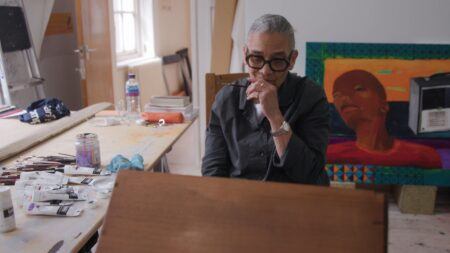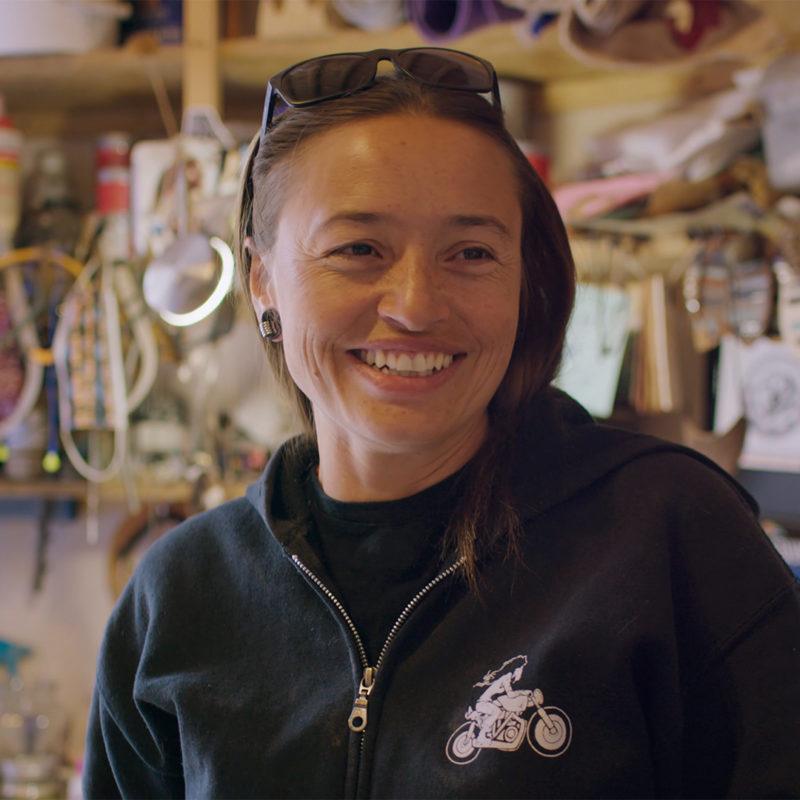Continue playing
(Time remaining: )
Play from beginning
Continue playing "{{ controller.videos[controller.getVideo(controller.currentVideo)].segmentParentTitle}}"
{{controller.videos[controller.getVideo(controller.currentVideo)].title}} has ended.
"Dream House"Rose B. Simpson
In an immersive and architectural installation, artist Rose B Simpson allows viewers to enter the different rooms of her psyche and walk through her dreams. Upon entering the installation, titled Dream House (2022), the viewer is confronted with their own shadow cast against the wall, a reminder of how our presence transforms the spaces we occupy. Simpson remarks, “I would ask people to enter into the space with the kind of reverence that we would enter into our own psychological spaces, that we would navigate our own internal spaces. Even if that sensitivity isn’t a comfortable neural pathway, we can build one, this is how we start.” Cultivating a greater awareness of the world and entities around us is central to both Dream House and Simpson’s larger artistic practice, as she gives opportunities for the viewer to recognize consciousness within objects we’ve collectively deemed inanimate. Throughout the multi-room installation, viewers encounter Simpson’s signature ceramic works alongside newer materials and media such as textiles and video (aspects of her practice she was able to explore through a two-year residency at the Fabric Workshop and Museum, where Dream House is currently installed).
For Simpson, Dream House marks a shift in her life and methodology: a hope that the values and aesthetics she shares within her practice can return to her. Within the installation, Simpson balances generosity and privacy, establishing boundaries that the viewer cannot cross and sections of the installation that cannot be seen. Of the four rooms within Dream House, only one is fully accessible to museumgoers. Within this room, the artist covers the ceiling with paper bowls in reference to a community practice of giving baskets in return for favors. “Some elders will have their whole ceiling covered in baskets,” says Simpson, “Your worth is based on how much you can give and how you’re recognized for the gifts you give.” Additionally, masks adorn the walls throughout the installation, their hollow eyes watching every spectator who moves through the space. For the artist, their watching signals a larger community that exists beyond our perception, a presence both comforting and critical. Dream House embodies Simpson’s prayer, a wish for a more intentional and balanced life and practice. “That’s my goal, you know,” the artist shares. “It’s my dream.”
Credits
Director: Andrea Chung. Executive Producer: Tina Kukielski. Series Producer: Ian Forster. Editor: Kira Dane. Camera: Jarred Alterman. Sound: Jackson Derbish. Colorist: Max Blecker. Sound Mix: Collin Blendell. Assistant Editor: Michelle Hanks. Music: Yotam Agam, Tamuz Dekel. Assistant Curator: Jurrell Lewis.
Artwork Courtesy: Rose B. Simpson, Jack Shainman Gallery, Jessica Silverman Gallery. Special Thanks: The Clay Studio, The Fabric Workshop and Museum, DJ Hellerman, Abby Lutz, Justin Rubich, Alec Unkovic.
Extended Play is presented by the Marina Kellen French Foundation, with support from The Andy Warhol Foundation for the Visual Arts and the Art21 Contemporary Council, public funds from the New York City Department of Cultural Affairs in partnership with the City Council, the New York State Council on the Arts with the support of the Office of the Governor and the New York State Legislature, the Every Page Foundation, the Henry Nias Foundation, and individual contributors.
Closed captionsAvailable in English, German, Romanian, Italian, Japanese, Korean, Chinese, Italian
Through the Art21 Translation Project, multilingual audiences from around the globe can contribute translations, making Art21 films more accessible worldwide. Translate this video now.
Interested in showing this film in an exhibition or public screening? To license this video please visit Licensing & Reproduction.
Rose B. Simpson was born in 1983 in Santa Clara Pueblo, New Mexico, where she lives and works today. In 2007, the artist received her BFA from the Institute of American Indian Arts and in 2011, she received her MFA in Ceramics from the Rhode Island School of Design. Simpson’s work reflects on the multilayered history of her home in New Mexico and of the United States, exploring modes of empowerment and resilience that carry traditions into the future. Working across media, the artist finds new ways to connect past and present, express experience and identity, and contemplate freedom and strength.
“I would ask people to enter into the space with the kind of reverence that we would enter into our own psychological spaces, that we would navigate our own internal spaces.”
Rose B. Simpson

